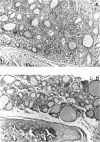Abstract
We have investigated the responsiveness to thyroglobulin (Tg) plus complete Freund's adjuvant (CFA) and B. pertussis in a variety of inbred and MHC congenic strains of rats in terms of both Tg-autoantibody titres and histological thyroiditis index. Severity of thyroiditis was strongly Tg-dependent and closely related to the RT.1-MHC haplotype. Phenotypic examination of the inflammatory thyroid infiltrate using single and double indirect immunofluorescence techniques revealed a high proportion of macrophages and T lymphocytes, mainly of the cytotoxic/suppressor subset, in the high responder strains. Thyroid epithelial class II MHC expression although not prominent was strain-restricted and related to the amount of Ia+ leukocyte infiltrate.
Full text
PDF






Images in this article
Selected References
These references are in PubMed. This may not be the complete list of references from this article.
- Champion B. R., Varey A. M., Katz D., Cooke A., Roitt I. M. Autoreactive T-cell lines specific for mouse thyroglobulin. Immunology. 1985 Mar;54(3):513–519. [PMC free article] [PubMed] [Google Scholar]
- Cohen S. B., Weetman A. P. Characterization of different types of experimental autoimmune thyroiditis in the Buffalo strain rat. Clin Exp Immunol. 1987 Jul;69(1):25–32. [PMC free article] [PubMed] [Google Scholar]
- Dijkstra C. D., Döpp E. A., Joling P., Kraal G. The heterogeneity of mononuclear phagocytes in lymphoid organs: distinct macrophage subpopulations in the rat recognized by monoclonal antibodies ED1, ED2 and ED3. Immunology. 1985 Mar;54(3):589–599. [PMC free article] [PubMed] [Google Scholar]
- JONES H. E., ROITT I. M. Experimental auto-immune thyroiditis in the rat. Br J Exp Pathol. 1961 Dec;42:546–557. [PMC free article] [PubMed] [Google Scholar]
- Kotani T., Komuro K., Yoshiki T., Itoh T., Aizawa M. Spontaneous autoimmune thyroiditis in the rat accelerated by thymectomy and low doses of irradiation: mechanisms implicated in the pathogenesis. Clin Exp Immunol. 1981 Aug;45(2):329–337. [PMC free article] [PubMed] [Google Scholar]
- Lillehoj H. S., Beisel K., Rose N. R. Genetic factors controlling the susceptibility to experimental autoimmune thyroiditis in inbred rat strains. J Immunol. 1981 Aug;127(2):654–659. [PubMed] [Google Scholar]
- Lillehoj H. S., Rose N. R. Humoral and cellular immune response to thyroglobulin in different inbred rat strains. Clin Exp Immunol. 1982 Mar;47(3):661–669. [PMC free article] [PubMed] [Google Scholar]
- Male D. K., Champion B. R., Pryce G., Matthews H., Shepherd P. Antigenic determinants of human thyroglobulin differentiated using antigen fragments. Immunology. 1985 Mar;54(3):419–427. [PMC free article] [PubMed] [Google Scholar]
- Massa P. T., ter Meulen V., Fontana A. Hyperinducibility of Ia antigen on astrocytes correlates with strain-specific susceptibility to experimental autoimmune encephalomyelitis. Proc Natl Acad Sci U S A. 1987 Jun;84(12):4219–4223. doi: 10.1073/pnas.84.12.4219. [DOI] [PMC free article] [PubMed] [Google Scholar]
- Penhale W. J., Farmer A., Urbaniak S. J., Irvine W. J. Susceptibility of inbred rat strains to experimental thyroiditis: quantitation of thyroglobulin-binding cells and assessment of T-cell function in susceptible and non-susceptible strains. Clin Exp Immunol. 1975 Jan;19(1):179–191. [PMC free article] [PubMed] [Google Scholar]
- Rayner D. C., Lydyard P. M., de Assis-Paiva H. J., Bidey S., van der Meide P., Varey A. M., Cooke A. Interferon-mediated enhancement of thyroid major histocompatibility complex antigen expression. A flow cytometric analysis. Scand J Immunol. 1987 Jun;25(6):621–628. doi: 10.1111/j.1365-3083.1987.tb01088.x. [DOI] [PubMed] [Google Scholar]
- Rose N. R. Differing responses of inbred rat strains in experimental autoimmune thyrioditis. Cell Immunol. 1975 Aug;18(2):360–364. doi: 10.1016/0008-8749(75)90064-7. [DOI] [PubMed] [Google Scholar]
- Taverne J., Rayner D. C., Van der Meide P. H., Lydyard P. M., Bidey S. P., Cooke A. Cytotoxicity of tumor necrosis factor for thyroid epithelial cells and its regulation by interferon-gamma. Eur J Immunol. 1987 Dec;17(12):1855–1858. doi: 10.1002/eji.1830171229. [DOI] [PubMed] [Google Scholar]
- Tomazic V., Rose N. R., Shreffler D. C. Autoimmune murine thyroiditis. IV. Localization of genetic control of the immune response. J Immunol. 1974 Mar;112(3):965–969. [PubMed] [Google Scholar]
- Vladutiu A. O., Rose N. R. Autoimmune murine thyroiditis relation to histocompatibility (H-2) type. Science. 1971 Dec 10;174(4014):1137–1139. doi: 10.1126/science.174.4014.1137. [DOI] [PubMed] [Google Scholar]
- Woda B. A., McFadden M. L., Welsh R. M., Bain K. M. Separation and isolation of rat natural killer (NK) cells from T cells with monoclonal antibodies. J Immunol. 1984 May;132(5):2183–2184. [PubMed] [Google Scholar]



